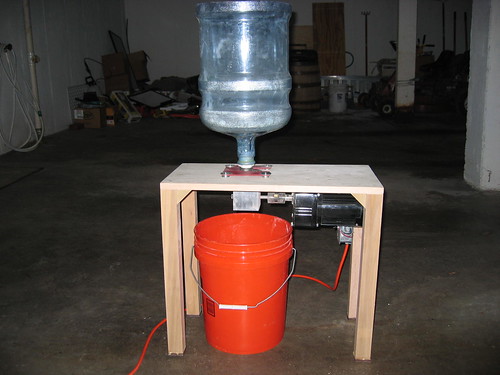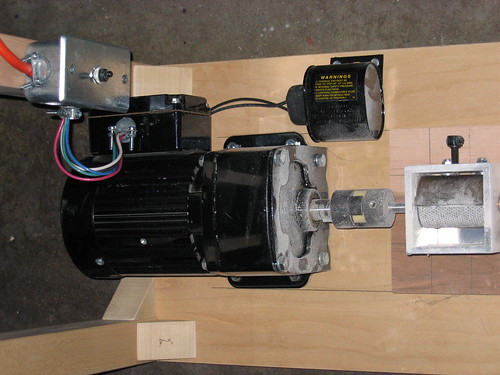StAnthonyB
Well-Known Member
Who here uses the Phil Mill to get their crush on?

I do and it works great. Been using it for 3 years now. I have modified it and now hook a drill up to it to avoid the crank.
TD


Where does one purchase a Phil Mill? Are they still being made?
The slow RPM is a good thing concerning quality of the crush, from what I understand. The Phil Mill does give a good crush. Many have the opinion that it is superior in this regard and that it is the slow speed which detracts from it. Although I haven't tried it, I will work at conditioning the malt before crush. I have looked at many pictures online here and there and from what I can tell conditioning the malt is a beneficial technique to learn how to do.
To frame why I ask about mechanizing the Phil Mill I propose that a little labor does not bother me and yet too much labor is not a good thing. My argument has always been that a little sweat makes for better appreciation, and this is particularly applicable to homebrew. But, making the labor the end all is certainly a mistake. In examining ways to keep my beer handcrafted while at the same time not making the process so laborious that I become a slave to the process in a way that is dehumanizing, the beer making process can help us understand that which lays beyond the beer itself. There is certainly a maxima and minima to how much beer is brewed and fermented at one time. I would say that five gallons is good. Ten gallons is better. Without digressing into that discussion any further, producing anything more than a barrel at one time for personal consumption is patently absurd. It would turn a man into a beer making and drinking factory; that which, is no good for the gut, the liver, and by some extension, the soul.
Perhaps that was too Catholic, but today is Sunday; so, I'll let it pass.
Thank you for the ideas on mechanizing the Phil Mill and BTW I love the dog wearing the wig. Hahaha.
I don't entirely agree on the sweat equity thing. There's more than enough to keep me occupied while brewing so I don't feel the need to manually grind the grain. Not that I'm that lazy, but IMO the time and effort is better expended elsewhere in the process.
Regarding batch size, I usually brew either 6 or 12 gallon batches. Much depends on what I plan to do with the finished beer. Sometimes I make beer to take to gatherings where I need to bring along multiple kegs and a variety of styles. The six gallon batches permit me to brew more frequently with more style variation, so there can be an advantage to brewing small. I would probably brew one barrel batches at times if I had the capacity.
Regarding barrel sized brewing, I would whip barrel sized brews if I had a sufficient technique and sets of recipes, etc. Filling two half-barrel cornelius kegs or even finding Golden Gate kegs, for the sake of 'real beer', is certainly laudible. I have considered using a half-barrel cornelius as a secondary and also as a priming vessel due to greater uniformity of priming when dealing with larger volumes.
I will agree that there are plenty of things to keep the brewer busy. Cleaning can be a task in and of itself. You wouldn't happen to have a manufacturer's part number on that motor of yours, would you? I may just go ahead and swing by the supply house and rig it up. In motorizing the Phil Mill, perhaps, something to throttle the voltage up and done in controlling the RPM of the motor could be in order in determining crush speed for various malts and their corresponding plumpness. I had totally forgotten about spyders. It has been so long since I rid of my old Chevy. One downside of driving a newer vehicle is that the section of my brain I used to use for mechanical applications has begun to wither. My renewed interest in homebrewing seemingly is remedying that rather quickly. That is a good thing.
Bonus points for using the old five gallon plastic water bottle. I've been eyeballing making a hopper out of the same thing for a few weeks now.
Here's a heavy duty drill motor from HB which should be more than enough to do the job:
http://www.harborfreight.com/cpi/ctaf/Displayitem.taf?itemnumber=93632
That one is supposed to have a double gear reduction, so it should run slower with more torque and it has variable speed control.
Throttling the voltage on AC motors for speed control does not work very well at all and under a load it's sometimes worse. Gear reduction (or belts and sheaves) is preferable by far IMO.
The one Phil Mill that I can find for sale is $91 ?!? For $40, maybe $50 I could see ponying up the money for a one roller mill but for only $30 more than $90 you can get a BC mounted, with hopper, delivered.
So, is the Phil Mill available anywhere for $40 or $50?
Enter your email address to join: